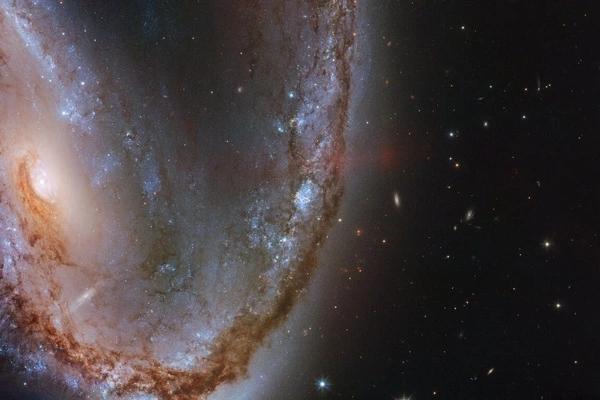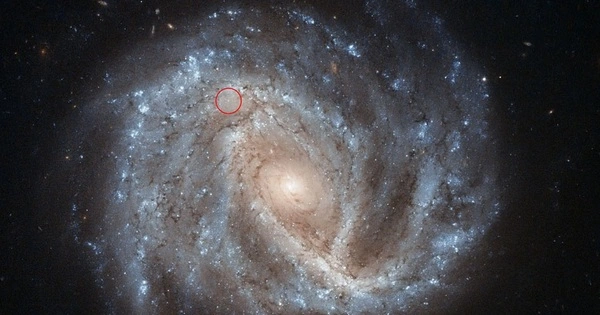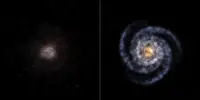It’s not uncommon to find a surviving star at the site of a massive supernova explosion, which would normally obliterate everything around it, but new Hubble Space Telescope research has provided a long-awaited clue to a specific type of stellar death. Astronomers have discovered no trace of the former star’s outermost layer of hydrogen in some supernova cases. What became of the hydrogen? Hubble’s identification of a surviving companion star on the scene of supernova 2013ge lends credence to the theory that companion stars are to blame, siphoning away their partners’ outer shells before death.
The discovery also lends credence to the theory that most massive stars form and evolve as binary systems. It may also serve as a prequel to another cosmic drama: In time, the surviving, massive companion star will also supernova, and if the remnant cores of both stars are not flung from the system, they will merge and produce gravitational waves, shaking the fabric of space itself.
A companion star previously hidden in the glare of its partner’s supernova has been discovered by NASA’s Hubble Space Telescope as a witness at the scene of a star’s explosive death. The find is a first for a specific type of supernova, one in which the star was stripped of its entire outer gas envelope before exploding.
The discovery sheds light on the binary nature of massive stars, as well as a possible precursor to the ultimate merger of the companion stars, which would reverberate across the universe as gravitational waves, ripples in the fabric of spacetime itself.
The signatures of various elements in supernova explosions are detected by astronomers. These elements are layered together like an onion before a supernova. Hydrogen is found in a star’s outermost layer, and if no hydrogen is found in the aftermath of a supernova, it means it was stripped away before the explosion.
The cause of the hydrogen loss had previously been unknown, and astronomers have used Hubble to look for clues and test theories to explain these stripped supernovae. The new Hubble observations provide the best evidence yet to support the theory that an unseen companion star siphons off its partner star’s gas envelope before it explodes.
Understanding the lifecycle of massive stars is especially important because all heavy elements are created in their cores and supernovae. These elements comprise a large portion of the observable universe, including life as we know it.
Alex Filippenko
“This was the moment we had been waiting for, finally seeing evidence for a binary system progenitor of a fully stripped supernova,” said Ori Fox, lead investigator on the Hubble research program at the Space Telescope Science Institute in Baltimore, Maryland. “The goal is to move this area of study from theory to working with data and seeing what these systems look like in practice.”
Fox’s team used Hubble’s Wide Field Camera 3 to study the region of supernova (SN) 2013ge in ultraviolet light, as well as previous Hubble observations in the Barbara A. Mikulski Archive for Space Telescopes. The light of the supernova faded over time, from 2016 to 2020, but another nearby source of ultraviolet light at the same location remained bright. The team proposes that this underlying source of ultraviolet emission is the surviving binary companion to SN 2013ge.
Two by two?
Previously, scientists hypothesized that the strong winds of a massive progenitor star could blow away its hydrogen gas envelope, but observational evidence did not support this. Astronomers developed theories and models to explain the disconnect, in which a binary companion siphons off the hydrogen.
“Many different lines of evidence have told us in recent years that stripped supernovae are most likely formed in binaries, but we have yet to see the companion. So much of studying cosmic explosions is like forensic science: looking for clues and comparing theories. We can see this directly because of Hubble “said Maria Drout, a member of the Hubble research team at the University of Toronto.

Prior observations of SN 2013ge revealed two peaks in ultraviolet light, rather than the single peak seen in most supernovae. One explanation for the double brightening, according to Fox, is that the second peak shows when the supernova’s shock wave collided with a companion star, a possibility that now appears much more likely. According to Hubble’s most recent observations, the companion star was significantly jostled, including the hydrogen gas it had siphoned from its partner, but it was not destroyed. Fox compares the effect to a jiggling bowl of jelly that will eventually return to its original shape.
While additional confirmation and similar supporting discoveries need to be found, Fox said that the implications of the discovery are still substantial, lending support to theories that the majority of massive stars form and evolve as binary systems.
One to Watch
Unlike supernovae that have a puffy shell of gas to light up, the progenitors of fully stripped-envelope supernovae have proven difficult to identify in pre-explosion images. Now that astronomers have been fortunate enough to identify the surviving companion star, they can use it to work backward and determine characteristics of the star that exploded, as well as the unprecedented opportunity to witness the aftermath with the survivor.
As a massive star, SN 2013ge’s companion will also go supernova. Its former partner is now most likely a compact object, such as a neutron star or black hole, and the companion will most likely follow suit.
The original companion stars’ closeness will determine whether they stay together. If the distance is too great, the companion star will be flung out of the system to wander alone across our galaxy, a fate that could explain many seemingly solitary supernovae. If the stars were close enough to each other before the supernova, they will continue to orbit each other as black holes or neutron stars. In that case, they would eventually spiral toward each other and merge, generating gravitational waves in the process.
That is an exciting prospect for astronomers, as gravitational waves are a branch of astrophysics that has only recently begun to be investigated. They are waves or ripples in the fabric of spacetime itself, as predicted by Albert Einstein in the early twentieth century. The Laser Interferometer Gravitational-Wave Observatory was the first to observe gravitational waves directly.
“With the surviving companion of SN 2013ge, we could potentially be seeing the prequel to a gravitational wave event,” Fox said. Fox and his collaborators will be working with Hubble to build up a larger sample of surviving companion stars to other supernovae, in effect giving SN 2013ge some company again.
“Beyond simply understanding the supernova, there is enormous potential. Because we now know that the majority of massive stars in the universe form in binary pairs, observations of surviving companion stars are required to help understand the details of binary formation, material-swapping, and co-evolutionary development. It’s an exciting time to be an astronomer “Fox stated.
“Understanding the lifecycle of massive stars is especially important because all heavy elements are created in their cores and supernovae. These elements comprise a large portion of the observable universe, including life as we know it” Alex Filippenko of the University of California, Berkeley, is a co-author.
















